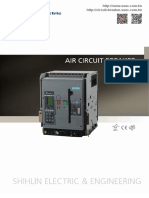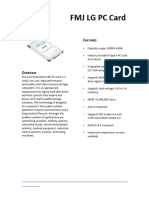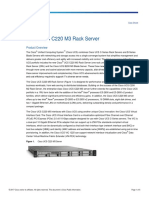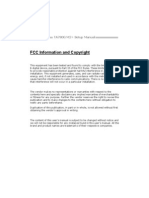USB3 Accelerator Module Datasheet
USB3 Accelerator Module Datasheet
Uploaded by
Sourabh SaikiaCopyright:
Available Formats
USB3 Accelerator Module Datasheet
USB3 Accelerator Module Datasheet
Uploaded by
Sourabh SaikiaOriginal Title
Copyright
Available Formats
Share this document
Did you find this document useful?
Is this content inappropriate?
Copyright:
Available Formats
USB3 Accelerator Module Datasheet
USB3 Accelerator Module Datasheet
Uploaded by
Sourabh SaikiaCopyright:
Available Formats
Accelerator Module datasheet
Version 1.4.1 (with USB3)
Features
● Google Edge TPU ML accelerator
○ 4 TOPS peak performance (int8)
○ 2 TOPS per watt
● Integrated power management
● PCIe Gen2 x1, USB 2.0, or USB 3.0 (3.1 Gen 1) interface
● Surface-mounted (LGA) module
● Size: 15.0 x 10.0 x 1.5 mm
● Weight: 0.67 g
● Operating temp: -40 to +85 °C
● RoHS compliant
Description
The Coral Accelerator Module is a multi-chip module (MCM) designed to perform high-speed inferencing for machine
learning (ML) models. It includes the Edge TPU ML accelerator with integrated power control, and it can be connected over
a PCIe Gen2 x1, USB2, or USB3 (3.1 Gen 1) interface.
The Edge TPU is a small ASIC designed by Google that accelerates TensorFlow Lite models in a power efficient manner: it's
capable of performing 4 trillion operations per second (4 TOPS), using 2 watts of power—that's 2 TOPS per watt. For
example, one Edge TPU can execute state-of-the-art mobile vision models such as MobileNet v2 at almost 400 frames per
second. This on-device ML processing reduces latency, increases data privacy, and removes the need for a constant
internet connection.
Confidential: This is a special version of the Accelerator Module datasheet, intended only for select customers who want
to integrate the module using the USB 3.0 interface, which requires special design considerations.
Ordering information
Part number Description
G313-06329-00 Coral Accelerator Module
See https://coral.ai/products/accelerator-module/.
Coral.ai | Copyright 2020 Google LLC.
Accelerator Module datasheet v1.4.1 (with USB3)
G313-06329-00
Table of contents
Features 1
Description 1
Ordering information 1
Table of contents 2
1 Block diagram 3
2 Electrical characteristics 4
2.1 Recommended operating conditions 4
2.2 Absolute maximum ratings 4
2.3 Logic threshold levels 4
2.4 Power consumption 5
2.5 Peak performance 5
2.6 IO supplies 6
3 Pin layout and description 7
4 Application details 9
4.1 Example circuit designs 9
4.1.1 PCIe 9
4.1.2 USB 2.0 10
4.1.3 USB 3.0 11
4.2 Trace length compensation 12
4.3 Power-on sequence 13
4.3.1 PCIe 13
4.3.2 USB 2.0 and USB 3.0 13
4.4 Power delivery network design 14
4.5 Thermal management 14
4.5.1 Thermal limits and resistance 14
4.5.2 Temperature warnings and frequency scaling (PCIe only) 15
4.5.3 Fixed operating frequency (USB only) 15
4.6 Software requirements 15
5 Package information 16
5.1 Package and pin dimensions 16
5.2 Land pattern 17
5.3 Soldering recommendations 18
5.4 Tape and reel information 19
5.5 Weight 21
5.6 Storage conditions 22
6 Document revisions 22
Coral.ai | Copyright 2020 Google LLC. 2
Accelerator Module datasheet v1.4.1 (with USB3)
G313-06329-00
1 Block diagram
Figure 1. Accelerator Module functional block diagram
Coral.ai | Copyright 2020 Google LLC. 3
Accelerator Module datasheet v1.4.1 (with USB3)
G313-06329-00
2 Electrical characteristics
2.1 Recommended operating conditions
Table 1. Recommended operating conditions
Parameter Min Typical Max
Case operating temperature (Tc) 1 -20 °C 70 °C
Power supply (VIN) 3.1 V 3.3 V 3.63 V
PMIC digital I/O power supply (AON) 1.7 V 1.8 V 3.63 V
1
Case temperature is defined as the surface temperature of the module. For details, see 4.5 Thermal management.
2.2 Absolute maximum ratings
Exceeding the absolute ratings can cease operation and possibly cause permanent damage. Exposure to absolute ratings
for extended periods of time can also adversely affect reliability.
Table 2. Absolute maximum ratings
Parameter Min Max
Case operating temperature (Tc) -40 °C 85 °C 1
Edge TPU junction temperature (Tj) -40 °C 115 °C
Storage temperature -40 °C 85 °C
Power supply (VIN) -0.3 V 3.63 V
PMIC digital I/O power supply (AON) -0.3 V VIN + 0.3 V
PMIC digital I/O 2 -0.3 V AON + 0.3 V
Edge TPU digital I/O 3 -0.3 V 2.1 V
1
The maximum operating temperature of the case assumes that the Edge TPU junction temperature (Tj) does not exceed its
absolute maximum rating, which depends on the power consumption and thermal management in your system.
2
PMIC digital I/O pins: PGOOD4, PMIC_EN
3
Edge TPU digital I/O pins: USB_SEL, RST_L, INTR, CLKREQ_L, SD_ALARM
2.3 Logic threshold levels
Table 3. Digital I/O logic thresholds
Parameter Output Input
Low-level max (VOL) High-level min (VOH) Low-level max (VIL) High-level min (VIH)
PMIC digital I/O1 0.4 V AON - 0.4 V 0.5 V 1.35 V
1
PMIC digital I/O pins: PGOOD4, PMIC_EN
Coral.ai | Copyright 2020 Google LLC. 4
Accelerator Module datasheet v1.4.1 (with USB3)
G313-06329-00
2.4 Power consumption
The power consumed by the module depends on the ML model, the number of inferences per second, and the operating
frequency of the Edge TPU. For some examples of average sustained power consumption, see table 4. However, it's also
important that you consider the peak current transients that occur during inferencing.
The maximum current drawn by the Edge TPU is typically much higher than the average current. That's because when the
Edge TPU executes an ML model, it repeatedly activates a large number of arithmetic logic units (ALUs) simultaneously,
resulting in a pattern of brief but large current transients. Each model architecture also activates a different set and different
number of ALUs, meaning the magnitude and the shape of the transient current very much depends on the model.
Although the average current drawn from the 3.3V supply by the Edge TPU is typically less than 500 mA, brief current
transients that occur during inferencing can reach roughly 3 A. These spikes also occur suddenly: even a simple model can
generate current transients in excess of 1 A/μs from a single Edge TPU. However, these numbers are representative of only
the models tested at Google, and your numbers will vary. To determine the actual peak supply current, you should observe
the current when running the models you will deploy in production.
For more information, see section 4.4 Power delivery network design.
Table 4. Examples of long-term sustained power during inferencing
Model 1 Low operating frequency Reduced operating frequency Max operating frequency
125 MHz 250 MHz 500 MHz
MobileNet v2 0.6 W (7.1 ms @ 141 fps) 0.9 W (3.9 ms @ 256 fps) 1.4 W (2.4 ms @ 416 fps)
Inception v3 0.5 W (58.7 ms @ 17 fps) 0.6 W (51.7 ms @ 19.3 fps) 0.7 W (48.2 ms @ 20.7 fps)
1
Pre-compiled models were tested using models_benchmark.cc
Typical idle power consumption is 375 - 400 mW.
Table 5. Maximum current consumed by the module (for power supply design)
Parameter Max
Power supply current (VIN) Varies (read above)
PMIC digital I/O power supply current (AON) 10 mA
2.5 Peak performance
Peak performance when the Edge TPU is running at the maximum operating frequency:
● 4 trillion operations per second (4 TOPS), 8-bit fixed-point math
● 2 TOPS per watt
Coral.ai | Copyright 2020 Google LLC. 5
Accelerator Module datasheet v1.4.1 (with USB3)
G313-06329-00
2.6 IO supplies
Note: USB3.0 designs that use I2C require option B (dual supply) as the PMIC and TPU I2C lines are tied together.
The Coral Accelerator Module has two distinct IO supply voltages: one for the PMIC (AON) and one for the Edge TPU. The
Edge TPU IO supply is always 1.8 V, generated internally from the 3.3 V main input source (VIN). This means that you have
two options for the module power supplies, depending on the AON supply provided:
A. Mixed IO voltages (single 3.3 V supply):
Provide 3.3 V to AON, allowing the PMIC IOs to run at 3.3 V (Edge TPU IOs still run at internally-generated 1.8 V).
This requires additional design considerations to ensure that the Edge TPU inputs are never driven beyond 1.8 V.
Most notably, this means that RST_L, USB_SEL (for USB designs), and CLKREQ_L (for PCIe designs) should be
restricted to 1.8 V levels. Additionally, we recommend grounding pins 49 and 50, as these IOs are connected
between the Edge TPU and PMIC in the module and have a very weak pull up (100k) to 1.8 V.
B. All IO voltages at 1.8 V (dual supply):
Provide 1.8 V to AON, allowing all the module's IOs to run at the same level (1.8 V). Although this does require a
second supply (because the VIN power supply must be 3.3 V), it requires no additional design considerations.
In either scenario, the Edge TPU outputs (INTR, SD_ALARM) are always using 1.8 V output logic levels. If connected to a
host with different logic levels, they must be level shifted. However, the PMIC_EN input thresholds are always compatible
with 1.8 V CMOS signaling, regardless of the AON supply voltage.
Coral.ai | Copyright 2020 Google LLC. 6
Accelerator Module datasheet v1.4.1 (with USB3)
G313-06329-00
3 Pin layout and description
Figure 2. Pin names and numbers (top view)
Coral.ai | Copyright 2020 Google LLC. 7
Accelerator Module datasheet v1.4.1 (with USB3)
G313-06329-00
Table 6. Module pins and descriptions
No. Pin name Type Supply Description
voltage
PCIe interface USB3 interface USB2 interface
1-3 GND - - Ground.
4 PCIE_TX_N Output 1.8 V PCIe/USB3 differential transmit pair. Has internal 0.1 μF DC-blocking cap. DNC.
5 PCIE_TX_P Output 1.8 V PCIe/USB3 differential transmit pair. Has internal 0.1 μF DC-blocking cap. DNC.
6 GND - - Ground.
7 PCIE_RX_P Input 1.8 V PCIe/USB3 differential receive pair. Tie low to avoid noise pickup.
8 PCIE_RX_N Input 1.8 V PCIe/USB3 differential receive pair. Tie low to avoid noise pickup.
9 GND - - Ground.
10 PCIE_REFCLK_N Input 1.8 V PCIe differential reference clock. Tie low to avoid noise pickup.
11 PCIE_REFCLK_P Input 1.8 V PCIe differential reference clock. Tie low to avoid noise pickup.
12 GND - - Ground.
13 USB2_D_P I/O 1.8 V DNC or tie low. USB D+ interface.
14 USB2_D_N I/O 1.8 V DNC or tie low. USB D- interface.
15-36 GND - - Ground.
37 PGOOD4 Output AON Optional. Power OK signal, active high. Has internal 10K pull-down. See 4.3 Power-on sequence.
38-48 GND - - Ground.
49 I2C_SDA I/O 1.8 V If using single 3.3 V supply (see 2.6 IO supplies), I2C bus data for If using single 3.3 V supply
ground. Otherwise, DNC. PHY programming. (see 2.6 IO supplies), ground.
Otherwise, DNC.
50 I2C_SCL Input 1.8 V I2C bus clock for
PHY programming.
51 GND - - Ground.
52 RESERVED - - Reserved. DNC.
53 PMIC_EN Input AON Power enable input. Must drive high to enable the module.
54 AON Power 1.8/3.3 V Power supply for digital communications (PMIC). See 2.6 IO supplies.
55 GND - - Ground.
56-67 VIN Power 3.3 V 3.3 V power supply.
68-75 GND - - Ground.
76 RST_L Input 1.8 V System reset. Active low. Has internal weak pull-down, but you must be sure it's held low during power-up.
Size the pull-up strength of the driver accordingly See 4.3 Power-on sequence.
77 INTR Output 1.8 V Optional. This is the first line that goes high at a DNC.
specified Edge TPU junction temperature.
Recommended for thermal management. Has internal
100k pull-down. See 4.5 Thermal management.
78 CLKREQ_L I/O 1.8 V Optional. Low-power mode option for PCIe. This is a DNC or tie low.
bidirectional open drain I/O. It should be
implemented as per the PCIe spec, including a
proper bidirectional level translator. On systems that
never invoke low power modes, this can be tied low.
79-81 GND - - Ground.
82 SD_ALARM Output 1.8 V Shutdown alarm. This is the second line that goes DNC.
high at a specified Edge TPU junction temperature.
This should trigger shutdown. Has internal 100k
pull-down. See 4.5 Thermal management.
83 USB_SEL Input 1.8 V DNC or tie low. Pull high (1.8 V) to enable USB2 or USB3 mode.
Has internal 4.7k pull-down. Use 0 ohm or tie
directly to 1.8 V.
84 PHY_PRG Input 1.8 V DNC. Set high (1.8 V) to DNC.
program USB PHY,
return low for
normal operation.
85 RESERVED - - Reserved. DNC.
86- GND - - Ground. Be sure to connect all center pads (89 - 120) to ground for thermal dissipation.
120
Coral.ai | Copyright 2020 Google LLC. 8
Accelerator Module datasheet v1.4.1 (with USB3)
G313-06329-00
4 Application details
4.1 Example circuit designs
You can integrate the Accelerator Module into a system design using either the PCIe or USB2 interface with very few
supporting components. The following diagrams show typical application circuits with either PCIe or USB2 interfaces.
Note: All ground terminals should be connected, especially the center contacts for thermal dissipation.
4.1.1 PCIe
Figure 3. Example PCIe circuit
Coral.ai | Copyright 2020 Google LLC. 9
Accelerator Module datasheet v1.4.1 (with USB3)
G313-06329-00
4.1.2 USB 2.0
Figure 4. Example USB2 circuit
Coral.ai | Copyright 2020 Google LLC. 10
Accelerator Module datasheet v1.4.1 (with USB3)
G313-06329-00
4.1.3 USB 3.0
Caution: The USB 3.0 PHY is very particular and we can't guarantee consistent operation with your specific design.
Due to the fact that USB 3.0 PHY on the Accelerator Module was tuned for short trace lengths, we can only support USB
3.0 on devices where the SoC and the Edge TPU are on the same PCB, with direct traces between the two. Typically, we
won't know whether the Accelerator Module works with USB 3.0 until the board is built and tested, and we are unable to
tune the PHY for your specific design.
Figure 4-1. Example USB3 circuit
Coral.ai | Copyright 2020 Google LLC. 11
Accelerator Module datasheet v1.4.1 (with USB3)
G313-06329-00
4.2 Trace length compensation
Table 7 describes the high-speed signals that require each pair to have the same total trace length. Due to space
constraints, not all tracings in the module match for each pair, as indicated in the table. You must incorporate any necessary
length compensation into your hardware.
Table 7. Pins that must have matching pair lengths, and their internal trace lengths.
Pair Pin name Trace length (mils) Time delay (ps)
PCIe clock PCIE_REFCLK_P 149.6 26.4
PCIE_REFCLK_N 158.5 28.0
PCIe TX PCIE_TX_P 104.0 16.6
PCIE_TX_N 104.0 16.6
PCIe RX PCIE_RX_P 125.0 19.9
PCIE_RX_N 119.0 19.0
USB2 data USB2_D_P 87.0 13.9
USB2_D_N 87.0 13.9
Coral.ai | Copyright 2020 Google LLC. 12
Accelerator Module datasheet v1.4.1 (with USB3)
G313-06329-00
4.3 Power-on sequence
4.3.1 PCIe
Figure 5. PCIe power-on sequence
4.3.2 USB 2.0 and USB 3.0
Figure 6. USB2/USB3 power-on sequence
Note: The 10 millisecond delay between PMIC_EN and RST_L is a conservative estimate. For a more immediate
response, monitor PGOOD4 and raise RST_L high 2 milliseconds after PGOOD4 is asserted. Otherwise, the illustrated
delay for RST_L should be based on the later of either PMIC_EN or VIN rising.
Coral.ai | Copyright 2020 Google LLC. 13
Accelerator Module datasheet v1.4.1 (with USB3)
G313-06329-00
4.4 Power delivery network design
Caution: If you do not properly design your power delivery network (PDN) to handle peak currents from the Edge TPU, it
can easily overwhelm your system and cause brownouts.
As described in section 2.4 Power consumption, the current drawn by the Edge TPU is highly variable and depends on the
model being executed, so you must design your power supply based on peak power. Although the average current drawn
by the Edge TPU might seem low (less than 500 mA), it can spike up to 3 A, depending on the model you're running. These
spikes also occur suddenly: even a simple model can generate current transients in excess of 1 A/μs, which can last several
tens of microseconds. However, these numbers are representative of only the models tested at Google, and your numbers
will vary based on your models.
To properly design a PDN for this module, you must consider the current envelopes generated when executing the ML
models you'll use in production. The current drawn by the Edge TPU is typically in the form of a few high current peaks, the
number of which depends on the model. The burst of high current peaks is usually followed by relatively long periods of
inactivity at idle currents. The peaks repeat at regular intervals, depending on the model architecture and number of
inferences per second.
The variation of current profile between models makes it very difficult to design a PDN that works for all applications.
Ultimately, you must optimize your own PDN based on the models you will use.
In particular, you must fine-tune the loop response in the DC/DC converter so it can absorb the load transients caused by
sudden and extreme changes in load current. Likewise, your PDN should maintain a low voltage ripple on the rail and avoid
internal overcurrent protection or inductor saturation events. It's important that you validate VIN’s PDN performance, such
as ripple noise and load step response performance when running your production models.
For more information about how to achieve and test these requirements, refer to the application information from the
vendor that provides your DC/DC converter.
4.5 Thermal management
Power dissipation in the Accelerator Module depends on the operating frequency and computational load. As the Edge
TPU heats up, performance may be affected, so it's important you design your system to manage thermal variations.
Note: The information in section 2.4 Power consumption includes some sustained power values (table 4) that can help
you estimate long-term thermal dissipation. But be sure you perform your own measurements, because total power
consumption varies based on the model you're running and other device characteristics.
4.5.1 Thermal limits and resistance
The case temperature Tc and the Edge TPU’s junction temperature Tj should stay below the maximum operating specs:
● Maximum case temperature Tc: 85 °C
● Maximum Edge TPU junction temperature Tj: 115 °C
Warning: Exceeding the maximum temperature can result in permanent damage to the Edge TPU and surrounding
components, and can possibly cause fire and serious damage, injury, or death.
Coral.ai | Copyright 2020 Google LLC. 14
Accelerator Module datasheet v1.4.1 (with USB3)
G313-06329-00
When designing a cooling solution for the module, be sure you consider the thermal behavior of the package when
attached to a heatsink. For simulation purposes, you can model the module using these absolute thermal resistance
properties:
● Junction-to-case thermal resistance θj-c: 10 °C/W
● Junction-to-board thermal resistance θj-b: 15 °C/W
These values represent the temperature difference between the Edge TPU’s junction and the top/bottom surfaces for a
given power flow across the interface, respectively. Figure 7 illustrates these temperature limit locations.
Figure 7. Module cross-section showing Edge TPU junction and module thermal properties
To estimate the effectiveness of your cooling solution—and to calculate a total thermal resistance—you should model θj-c
and θj-b thermal impedances in series with the thermal impedances of your interface material and heatsink design.
4.5.2 Temperature warnings and frequency scaling (PCIe only)
The Edge TPU includes an internal temperature sensor to help you make power management decisions. If you're using
PCIe, you can manually read the temperature, configure parameters that specify when the INTR and SD_ALARM pins assert
based on the current Edge TPU junction temperature, and specify trip-points for dynamic frequency scaling (DFS).
For details, read Manage the PCIe module temperature.
4.5.3 Fixed operating frequency (USB only)
If you connect the Coral Module using the USB interface, then the temperature readings and DFS functionality is not
available. Instead, the operating frequency is fixed and you must measure the system temperature yourself.
You can choose to run the Edge TPU at either the "maximum" (500 MHz) or "reduced" (250 MHz) operating frequency when
you install the Edge TPU runtime on the host system.
4.6 Software requirements
The Accelerator Module must be operated by the Edge TPU runtime and Coral PCIe driver, which are compatible with the
following systems:
● Linux:
○ 64-bit version of Debian 10 or Ubuntu 16.04 (or newer)
○ x86-64 or ARMv8 system architecture
● Windows:
○ 64-bit version of Windows 10
○ x86-64 system architecture
● All systems require support for MSI-X as defined in the PCI 3.0 specification
Coral.ai | Copyright 2020 Google LLC. 15
Accelerator Module datasheet v1.4.1 (with USB3)
G313-06329-00
5 Package information
5.1 Package and pin dimensions
Figure 8. Module dimensions
Coral.ai | Copyright 2020 Google LLC. 16
Accelerator Module datasheet v1.4.1 (with USB3)
G313-06329-00
5.2 Land pattern
To avoid a short circuit due to solder contact with the side shielding, be sure the solder for pads along the module
perimeter do not extend to the module outline.
Figure 9. Land pattern dimensions (symmetrical across the X-Y centerlines)
Coral.ai | Copyright 2020 Google LLC. 17
Accelerator Module datasheet v1.4.1 (with USB3)
G313-06329-00
5.3 Soldering recommendations
● The module requires a no-clean assembly process.
● Set the maximum reflow temperature below 260 °C.
● Do not exceed 2 cycles through reflow.
● Use rosin type flux or weakly active flux with a chlorine content of 0.2 wt % or less.
Caution: Exceeding 260 °C can cause damage to internal components.
Figure 10. Reflow soldering conditions example
Coral.ai | Copyright 2020 Google LLC. 18
Accelerator Module datasheet v1.4.1 (with USB3)
G313-06329-00
5.4 Tape and reel information
● 1,000 pieces per reel
● Material:
○ Base tape: plastic
○ Reel: plastic
○ Cover tape, cavity tape and reel are made with anti-static processing
Figure 11. Tape dimensions
Figure 12. Reel dimensions
Coral.ai | Copyright 2020 Google LLC. 19
Accelerator Module datasheet v1.4.1 (with USB3)
G313-06329-00
The tape is wound clockwise, with feeding holes to the right side as the tape is pulled toward the user.
Figure 13. Taping diagram
The cover tape and base tape are not adhered within the "no components" area for 250mm (min).
Figure 14. Leader and tail tape diagram
Coral.ai | Copyright 2020 Google LLC. 20
Accelerator Module datasheet v1.4.1 (with USB3)
G313-06329-00
The tear off strength against pulling of cover tape is 5N (min).
The peeling of force is 1.1N (max) in the direction of peeling, as shown in figure 15.
Figure 15. Peeling force diagram
This product is rated to MSL 3. To ensure proper storage conditions, tape and reel must be sealed within the provided
anti-humidity plastic bag. The bag contains a desiccant and humidity indicator.
Figure 16. Humidity indicator on plastic package
5.5 Weight
Table 8. Accelerator Module package weight (typical)
Component Weight
Module (one piece) 0.67 g
Taping 144 g
Reel 275 g
Total for full reel (approximate) 1.09 kg
Coral.ai | Copyright 2020 Google LLC. 21
Accelerator Module datasheet v1.4.1 (with USB3)
G313-06329-00
5.6 Storage conditions
● Please use this product within 6 months of receipt. If unused for more than 6 months, you must verify the product is
ready for soldering.
● While still in the anti-humidity packaging, the product should be stored at an ambient temperature from 5 to 35 °C
and humidity from 20 to 70% RH. (Packing materials may deform at temperatures over 40 °C).
● The product must not be stored in a corrosive environment gas (such as Cl2, NH3, SO2, NOx).
● Avoid any mechanical shock, such as dropping the packaging materials.
This product is rated to MSL 3 (JEDEC Standard J-STD-020):
● After the packing is opened, it should be stored at ≤30 °C / ≤60% RH, and used within 168 hours.
● When the color of the humidity indicator on the packing changes, the product should be baked before soldering.
Baking conditions:
● 125+5/-0 °C, 24 hours, 1 time
● Bake individual modules on a heat-resistant tray because the materials (base tape, reel tape and cover tape) are
not heat-resistant.
6 Document revisions
Table 9. History of changes to this document
Version Changes
1.4.1 (March 2021) Added USB 3.0 information: Added "USB3 interface" column in table 6 and added section 4.1.3.
1.4 (January 2021) Updated module photo.
Changed VIN max to 3.6 V (was 6 V, which did not account for load switching outside the PMIC),
and AON max is now based on VIN max (table 2).
Added section 2.6 IO supplies.
Added "Supply voltage" column to table 6.
Updated USB2 circuit (figure 4) to tie the PCIE input lines low.
Improved land pattern illustration (figure 9).
Added note about possible USB 3.0 designs.
1.3 (September 2020) Fixed the name and time delay for PCIE_RX_N (table 7).
1.2 (August 2020) Changed max Edge TPU junction temperature (Tj) to 115 °C (was 125 °C, which is actually used
for HTOL and other qualifications).
1.1 (August 2020) Revised pinout descriptions.
Updated example circuit designs.
Miscellaneous copy edits.
1.0 (July 2020) Updated electrical characteristics, power consumption, thermal management, packaging specs,
and miscellaneous edits.
DRAFT (May 2020) Initial release
Coral.ai | Copyright 2020 Google LLC. 22
You might also like
- Lenovo ThinkPad L440 Wistron LOS 1 DIS UMA 12289 1 Rev 1Document102 pagesLenovo ThinkPad L440 Wistron LOS 1 DIS UMA 12289 1 Rev 1Ramdas KambleNo ratings yet
- xl710 x710 Performance Tuning Linux GuideDocument12 pagesxl710 x710 Performance Tuning Linux GuideKarthik SunkesulapatiNo ratings yet
- Symmetrix VMAX3 Internals EssentialsDocument92 pagesSymmetrix VMAX3 Internals EssentialspankuvermaNo ratings yet
- Coral Accelerator Module DatasheetDocument21 pagesCoral Accelerator Module DatasheetrobnewportsydneyNo ratings yet
- Esp32 Datasheet enDocument59 pagesEsp32 Datasheet enRaphaelNo ratings yet
- Esp32 Datasheet en PDFDocument64 pagesEsp32 Datasheet en PDFDiego LondoñoNo ratings yet
- Esp32 Datasheet enDocument60 pagesEsp32 Datasheet ensamsularief03No ratings yet
- Coral Mini PCIe DatasheetDocument10 pagesCoral Mini PCIe DatasheetzbacsiNo ratings yet
- Esp32 s2 Wrover - Esp32 s2 Wrover I - Datasheet - enDocument26 pagesEsp32 s2 Wrover - Esp32 s2 Wrover I - Datasheet - encesarNo ratings yet
- ESP32-S2-MINI-1 & ESP32-S2-MINI-1U: DatasheetDocument29 pagesESP32-S2-MINI-1 & ESP32-S2-MINI-1U: DatasheetYurii VovchenkoNo ratings yet
- Esp32-Pico-V3-02 DatasheetDocument33 pagesEsp32-Pico-V3-02 Datasheetuuu_raduNo ratings yet
- Esp32 Datasheet enDocument43 pagesEsp32 Datasheet enRenato HernandezNo ratings yet
- ArduinoMKR WiFi 1010Document15 pagesArduinoMKR WiFi 1010SolomanderNo ratings yet
- Original Commodore Business Machines Plus 4 Docs, The, (2003) (Lidovski, V)Document40 pagesOriginal Commodore Business Machines Plus 4 Docs, The, (2003) (Lidovski, V)BASILEIOS KATHOLOSNo ratings yet
- ESP32-WROOM-32E - UE - Datasheet v1.2Document35 pagesESP32-WROOM-32E - UE - Datasheet v1.2StefanoViganóNo ratings yet
- Berges Manual X4 EngelsDocument140 pagesBerges Manual X4 EngelsPeter HoogendoornNo ratings yet
- ABX00030 DatasheetDocument12 pagesABX00030 DatasheetMonisha K 21BEC1313No ratings yet
- ABX00023 DatasheetDocument15 pagesABX00023 DatasheetMonisha K 21BEC1313No ratings yet
- Esp32 s2 Wroom - Esp32 s2 Wroom I - Datasheet - en PDFDocument27 pagesEsp32 s2 Wroom - Esp32 s2 Wroom I - Datasheet - en PDFViki YusdiantoNo ratings yet
- Esp32 Pico v3 Zero - Datasheet - enDocument27 pagesEsp32 Pico v3 Zero - Datasheet - enANo ratings yet
- ESP32-S2-WROVER & ESP32-S2-WROVER-I: DatasheetDocument26 pagesESP32-S2-WROVER & ESP32-S2-WROVER-I: DatasheetWesllen Dias SouzaNo ratings yet
- WB2L Module Datasheet - Tuya IoT Development Platform - Tuya IoT Development PlatformDocument31 pagesWB2L Module Datasheet - Tuya IoT Development Platform - Tuya IoT Development PlatformMarcelo KrewerNo ratings yet
- Esp32 Wroom Da Datasheet enDocument30 pagesEsp32 Wroom Da Datasheet enJuan CecconiNo ratings yet
- ACS 1000 TechCatalog 3BHS125029 RevCDocument106 pagesACS 1000 TechCatalog 3BHS125029 RevCluis enrique granados mendozaNo ratings yet
- IO3xx-21 - Hardware Reference Manual v1.0Document13 pagesIO3xx-21 - Hardware Reference Manual v1.0pavizzNo ratings yet
- I2985 1.0en GEN2i User ManualDocument146 pagesI2985 1.0en GEN2i User ManualRoberto OvandoNo ratings yet
- AMKASYN Device Description Controller Card KW-R06Document47 pagesAMKASYN Device Description Controller Card KW-R06Isao TomitaNo ratings yet
- Micom P40 Agile P543/P545 (With Distance) : Technical ManualDocument778 pagesMicom P40 Agile P543/P545 (With Distance) : Technical ManualSWAPNILNo ratings yet
- Coral M2 DatasheetDocument12 pagesCoral M2 DatasheetNeacsu AndreiNo ratings yet
- Acs 1000 Technical CatalogDocument106 pagesAcs 1000 Technical CatalogMiguel LaraNo ratings yet
- TYWE3S Module Datasheet - Tuya Smart - DocumentationDocument26 pagesTYWE3S Module Datasheet - Tuya Smart - DocumentationMadhusudanan AshokNo ratings yet
- Omega2S DatasheetDocument30 pagesOmega2S Datasheetantonio0806123No ratings yet
- ABX00028 Datasheet-3235442Document13 pagesABX00028 Datasheet-3235442Yasser AbrahantesNo ratings yet
- Janitza BHB Umg103 CBM enDocument62 pagesJanitza BHB Umg103 CBM enRadu BarbuNo ratings yet
- TYWE3S Module Datasheet - Tuya Smart - DocumentationDocument26 pagesTYWE3S Module Datasheet - Tuya Smart - DocumentationNguyễn TuấnNo ratings yet
- ESP32-wrover Datasheet enDocument27 pagesESP32-wrover Datasheet enSection Maintenance LP-BlériotNo ratings yet
- ACS1000 Technical CatalogDocument106 pagesACS1000 Technical CatalogLuis Alejandro Prieto MujicaNo ratings yet
- Wimod Ic880A: DatasheetDocument32 pagesWimod Ic880A: Datasheetimam rismawanNo ratings yet
- MG15G1 - MCD 600 Operating Guide - en - UkDocument136 pagesMG15G1 - MCD 600 Operating Guide - en - UkasolelpanchoNo ratings yet
- WB2S Module Datasheet - Tuya Smart - DocsDocument28 pagesWB2S Module Datasheet - Tuya Smart - DocsTsejatiNo ratings yet
- Janitza BHB Umg103 CBM enDocument62 pagesJanitza BHB Umg103 CBM enKristijanNo ratings yet
- Omega2S Datasheet PDFDocument27 pagesOmega2S Datasheet PDFJairo Martínez EscobarNo ratings yet
- BIG-INNO EMCP MX100 Series Datasheet PDFDocument109 pagesBIG-INNO EMCP MX100 Series Datasheet PDFSteven ChowNo ratings yet
- Distributor: Breaker & Switchgears Overseas Sales DeptDocument58 pagesDistributor: Breaker & Switchgears Overseas Sales DeptLUATNo ratings yet
- FMJ LG PC Card DataSheetDocument19 pagesFMJ LG PC Card DataSheetPablo CalcagnoNo ratings yet
- Alstom - H382 Switch ManualDocument59 pagesAlstom - H382 Switch ManualThủy Thân ThiệnNo ratings yet
- Pantallas - STON - STAD070WT-05Document14 pagesPantallas - STON - STAD070WT-05jorge armando vega prietoNo ratings yet
- SYNDEM EduKit ManualDocument78 pagesSYNDEM EduKit Manualimrankhan1995No ratings yet
- esp32-s3-wroom-2_datasheet_enDocument50 pagesesp32-s3-wroom-2_datasheet_enalexandru ilieNo ratings yet
- Esp-S3-12k Module Datasheet v1.0.0Document25 pagesEsp-S3-12k Module Datasheet v1.0.0vmsperandioNo ratings yet
- Esp32-Solo-1 Datasheet enDocument24 pagesEsp32-Solo-1 Datasheet enRAJ VIGNESHNo ratings yet
- Dyn5ms ZM1 A1aDocument80 pagesDyn5ms ZM1 A1aluisNo ratings yet
- SPL_220691-ADocument8 pagesSPL_220691-Aigarcia.zaballosNo ratings yet
- Manuel Dutilisation Wp85 j1900Document51 pagesManuel Dutilisation Wp85 j1900Ryan BenNo ratings yet
- Esp32-Wroom-Da Datasheet enDocument31 pagesEsp32-Wroom-Da Datasheet enbgmi18shivamNo ratings yet
- Esp32 Solo 1 Datasheet En-1384705Document27 pagesEsp32 Solo 1 Datasheet En-1384705Inventor TestNo ratings yet
- ESP32Document51 pagesESP32joilleandro50No ratings yet
- SM-Uni_Encoder_Plus_UG1Document70 pagesSM-Uni_Encoder_Plus_UG1rjr2kg9nxxNo ratings yet
- DataSheet ERTEC200P-2 V1 0Document80 pagesDataSheet ERTEC200P-2 V1 0dupirulitoNo ratings yet
- Man Bis V 6107 039 CX05 CX06 en B21 Dok 933434 06 000Document132 pagesMan Bis V 6107 039 CX05 CX06 en B21 Dok 933434 06 000JoshNo ratings yet
- MG34Q402Document122 pagesMG34Q402Kis JozsefNo ratings yet
- Broadband Wireless Mobile: 3G and BeyondFrom EverandBroadband Wireless Mobile: 3G and BeyondWillie W. LuNo ratings yet
- Multiplexed Networks for Embedded Systems: CAN, LIN, FlexRay, Safe-by-Wire...From EverandMultiplexed Networks for Embedded Systems: CAN, LIN, FlexRay, Safe-by-Wire...No ratings yet
- PowerStore 3.0 Concepts and Features - Participant GuideDocument68 pagesPowerStore 3.0 Concepts and Features - Participant Guideloubnamostefaoui28No ratings yet
- SpecSheet Riverbed Family Product Xx50Document4 pagesSpecSheet Riverbed Family Product Xx50Josh Van AsNo ratings yet
- DL-H81M-GL Motherboard ManualDocument56 pagesDL-H81M-GL Motherboard Manualzeeshan_iraniNo ratings yet
- Stock Hikvision, Mercusys, Tplink Rev. 240524Document6 pagesStock Hikvision, Mercusys, Tplink Rev. 240524rachman.dreadoutNo ratings yet
- Apple M72 SchematicDocument86 pagesApple M72 Schematicchipmaster86No ratings yet
- Ecs h61h2 m12Document70 pagesEcs h61h2 m12moussa mankNo ratings yet
- Huawei Tecal E9000 CH121 Compute Node White PaperDocument40 pagesHuawei Tecal E9000 CH121 Compute Node White PaperSOS INFORMATIQUENo ratings yet
- TEXUMA Operation-ManualDocument79 pagesTEXUMA Operation-Manualko koNo ratings yet
- Intel® Ethernet Converged Network Adapter XL710: Product BriefDocument4 pagesIntel® Ethernet Converged Network Adapter XL710: Product Briefmatthew_mk_au2271No ratings yet
- Gigabyte Ga-78lmt-Usb3 Rev 6.01Document31 pagesGigabyte Ga-78lmt-Usb3 Rev 6.01draj1968No ratings yet
- Data - Sheet - c78-700626 UCS Server CiscoDocument6 pagesData - Sheet - c78-700626 UCS Server CiscoVictor Rafael Atencia UruetaNo ratings yet
- Modbus Plus Pcie-85 Interface Adapter User Guide: October 2015Document37 pagesModbus Plus Pcie-85 Interface Adapter User Guide: October 2015Эдуард КочеровNo ratings yet
- Yoga Slim 6 14IRH8 SpecDocument8 pagesYoga Slim 6 14IRH8 Specsagar mirchandaniNo ratings yet
- Dell PowerEdge RAID Controller H730PDocument2 pagesDell PowerEdge RAID Controller H730PQuang Thịnh LêNo ratings yet
- Da0tw7mb8g0 - Rev G - tw7 - Rev 3aDocument54 pagesDa0tw7mb8g0 - Rev G - tw7 - Rev 3aluisfeipezz100% (2)
- EFW HTG 830-PCIe PBDocument2 pagesEFW HTG 830-PCIe PBlitoduterNo ratings yet
- DSV Vip CatalogDocument4 pagesDSV Vip CatalogSamNo ratings yet
- Installation Guide V8.5.6.0 - CCTV CameraDocument196 pagesInstallation Guide V8.5.6.0 - CCTV CameraRajkumarNo ratings yet
- A78ga-M2t 080115Document55 pagesA78ga-M2t 080115Norazwan Md NorNo ratings yet
- HPE Superdome Flex Server Architecture and RAS Technical White Paper-A00036491enwDocument22 pagesHPE Superdome Flex Server Architecture and RAS Technical White Paper-A00036491enwjalvarez82No ratings yet
- Pro Tools 10.3.9 Read Me (M)Document30 pagesPro Tools 10.3.9 Read Me (M)Michael IncavoNo ratings yet
- Intel 7th Gen Core Family Mobile U y Processor Lines I o Datasheet Vol 1Document267 pagesIntel 7th Gen Core Family Mobile U y Processor Lines I o Datasheet Vol 1Salvatore BonaffinoNo ratings yet
- Dell EMC PowerEdge R450 Spec SheetDocument3 pagesDell EMC PowerEdge R450 Spec SheetRDNFO TINo ratings yet
- Sualaptop365.Edu - VN A14RMDocument37 pagesSualaptop365.Edu - VN A14RMJoão VictorNo ratings yet
- Toshiba Tecra A11 FHNSY1 DPL99060G01 A5A002688010 SchematicDocument131 pagesToshiba Tecra A11 FHNSY1 DPL99060G01 A5A002688010 Schematicxingyiservice.mdy123No ratings yet
- BCM957412A4120AC: Dual-Port 10 Gb/s Ethernet PCI Express Gen3 x8 Network Interface CardDocument16 pagesBCM957412A4120AC: Dual-Port 10 Gb/s Ethernet PCI Express Gen3 x8 Network Interface Card龔麗惠No ratings yet
- DP LAN Intel 14060 DriversDocument285 pagesDP LAN Intel 14060 Driversberto_716No ratings yet

























































































